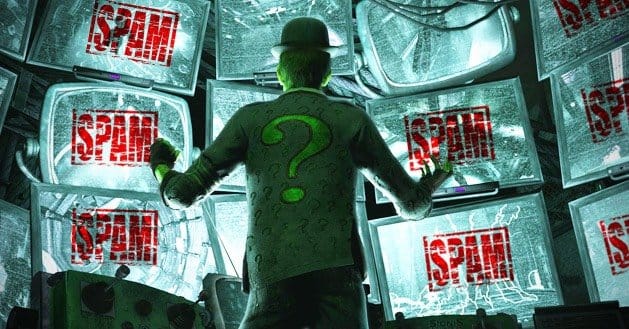 Written by ContentPowered.com
Written by ContentPowered.com
Currently, one of the major issues users have with Twitter is spam. Although Twitter has introduced several new features to combat spammers, many users believe they are ineffective. The process of reporting a spammer is simple; however, this process does not deter professional spammers. This is primary why Twitter spam has been steadily increasing since 2011.
How Spamming Works
On Twitter, popularity is measured by the amount of followers a user has acquired. This number is prominently displayed on the site and it is used by Google and many other sites to determine authority. If a user is followed by someone who is followed by tons of people, then the user’s influence will increase. Some researchers refer to this aspect of Twitter as a user’s “indegree”. In most cases, this provides a sort of Twitter-based link farming. This is what spammers use to find small-time users with just a few friends to larger users with thousands or millions of followers. Moreover, most Twitter users automatically follow users that follow them. This is an aspect of Twitter that spammers depend on.
Like many communication and social media platforms, Twitter faces a serious issue with spam. For Twitter, the problem revolves around 2 key areas:
- Fake user accounts that have acquired millions of followers
- Direct Message spam originating from fake user accounts
Over the last few years, Twitter has been unsuccessful at reducing the amount of existing fake Twitter accounts. Currently, there are several corrupt sites that allows user to buy millions of fake followers for $3000 or less. These fake accounts are problematic because not only do they enable DM spam but they falsify report influence. In most cases, these accounts appear legitimate but after becoming a follower, the account has the capability to send users DM messages that contain spam.
The issues with automated DM spam and DMs has become so widespread that the majority of active Twitter accounts find the DM interface unfeasible. Most active users never check the DM inbox and do not use DM notifications because of the amount of spam.
Fake user accounts assemble followers by using two methods. In some cases, the fake user account will register a large amount of accounts and have these accounts follow each other. These accounts will also follow a large number of active accounts so that a few legitimate users will become followers. This provides a direct path to DM spam. However, Twitter has implemented changes to the bulk following and automation policy to combat this issue.
When considering this method on a broad scale, it appears to be an effective solution. The fake accounts that are created using automation are not as successful if the apps that they use are prevented from completing automation tasks. However, the problem with this solution is that fake spam accounts never use legitimate Twitter apps to create accounts. Twitter has battled this problem with a range of restrictions surrounding automation that attempt to make it difficult to create accounts without significant manual input. For the most part, this method has had minimal success. Twitter monitors usage of the system closely in order to suspend accounts that abuse policy rules; however, most fake accounts do not use the current system. There are several prohibited Twitter tools that evade the API and perform similar to web browsers. This helps to create fake automated requests and build a large amount of followers.
Two Reasons Spam Will Continue to Increase
- The process to create an account on Twitter is simple and straightforward. For the most part, anyone with a brain and an email address can create a Twitter account. Although, a distinct email address is required, spammers can create a new email addresses for free with Yahoo and Gmail. In the event Twitter deactivates an account, a spammer can simply create a new profile using another email address.
- Most Twitter users do not utilize the Twitter interface. Many users download 3rd party apps that allow them to post to a feed without visiting the actual Twitter page. When a user needs to report a spammer, the user has to open the Twitter home page, locate the offensive Tweet, and then click on the user’s profile link in order to report it. For many users, this requires too much effort.
How To Solve The Problem
One of the only ways to solve the spam problem is to implement stronger limits. This will affect how the social graph changes are executed on Twitter. If a spam accounts does not use the API, this offers solutions that affect usage on Twitter. This places hard limits on the number of users an account can follow daily. Additionally, changing the way the current limits are implemented can eliminate consistent social graph activity.
Presently, Twitter has a limit that prevents users from following more than 2,000 users. This is only applicable to users that have similar users following them. Most experts believe that lowering this limit to fewer than 1,000 and preventing users from un-following for a period of 7 days would be an effective solution to this issue.
Overall, the process would resemble this scenario: @fake_profile starts following 1,500 users and reaches the following limit. 12 hours later, @fake_profile un-follows 800 users that never started following them. The @fake_profile would be allowed to follow another 1,000 users immediately. However, the new system would make the fake account wait 7 days before all the un-follows are deleted and the follower limit is restored. This would potentially make the fake account wait a week before it could begin following again.
In most cases, this process would limit the ability of fake accounts to follow large numbers of users. More importantly, these accounts could not continually perform social graph activity. This process would encourage real users to create a following organically and spark interest with other users to build legitimate followers. It is important that accounts that are verified are excluded from the user limit policy.
Furthermore, Twitter should introduce innovative tools that quickly detect spam accounts. Twitter should use tools that incorporate a spam score that detects how probable it is that an account is fraudulent. This tool could measure simple user indicators, and plug them into a probability algorithm. This could detect spam accounts with an extremely high accuracy. There are currently tools available similar to this process, but Twitter has yet to completely invest. Tools like this would allow Twitter to combat social graph spam and deactivate fake accounts without penalizing active users.
Spam On Twitter Can Be Combated
In most cases, if a user is not a follower, fake accounts and spammers can’t do much harm. However, some users find it somewhat embarrassing when fake services show that a large amount of followers are fake. Moreover, it misrepresents how many users an account can reach through Twitter.
Spammers and fake accounts are a real issue for Twitter that will steadily increase if a solution is not created. Most users automatically following users that follow them and don’t pay attention to whom they are actually following. This is what makes fake accounts and spammers so successful. It is important to remember that the users an account follows say volumes about the profile. Users should question accounts and profiles with obvious discrepancies. When using Twitter be weary of fake accounts and spammers.




